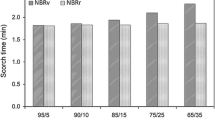Summary
Addition of reclaimed rubber affected mechanical properties, processing and rheological behavior of rubber compounds. Sulfur left in reclaimed rubber affected curing process of NR/reclaimed rubber blends. The most suitable curing was achieved with ratio 1:1 of natural rubber and reclaimed rubber which was used in this study. Presence of fillers in reclaimed rubber, non-homogeneity of phases, non-uniform filler dispersion and lower molecular weight of reclaimed rubber due to chain scission in reclaiming process caused diminishing of mechanical properties of NR/reclaimed blends, particularly dynamic-based properties. Reclaimed rubber also affected rheological behavior of natural rubber. In a strain sweep viscoelastic test, it could be observed that NR/reclaimed blend show more non-linear viscoelastic and viscous behavior than predicted one which was due to non-homogenized phases. This non-homogenized morphology was detected using scanning electron microscopy (SEM) and the blend with ratio 1:1 had the most homogenized morphology.
Similar content being viewed by others
References
T.D. Sreeja (2003) Polym. Plast. Tech. and Eng., 42, 2, 236–252
Jin Kuk Kim (2000), J. Ap. Pol. Sci., 78, 8, 1573–1577
A.A. Phadke (1983) Rubber Chemistry and Technology, 56, 4, 726–736
S.R. Fix (1980) Elastomerics, 112, 6, 38–40
V.Yu Levin (1996) Rubber Chemistry and Technology, 69, 1, 92 - 104
M. Tapale (1998) Journal of Applied Polymer Science, 70, 10, 2007–2019
T.D. Sreeja (2000) Polym. Plast. Technol.Eng. 39, 3, 501–512
G. Mathew (2003) Progress in Rubber Plastics Recycling Technology, 19, 4, 205–230
N. Sombatsompop (2003) Journal of Applied Polymer Science, 87, 10, 1723–1731
S.G. Reena (1997) Journal of Elastomers and Plastics, 29, 1, 1997, 83–91
T.D. Sreeja (2002) Polym. Plast. Technol. Eng., 4, 1, 77–89
P.A. Nelson (2004) Polym. Plast. Technol. Eng., 43, 1, 245–260
P.A. Nelson (2002) Progress in Rubber Plastics Recycling Technology, 18, 2, 85–97
T.D. Sreeja (2002) Journal of Elastomers and Plastics, 34, 2, 145–155
P.A. Nelson (2003) Progress in Rubber Plastics Recycling Technology, 19, 3, 171–188
T.D. Sreeja (2001) Advance in Polymer Technology, 20, 4, 281–288
P. Neratia (2002) Journal of Applied Polymer Science, 83, 9, 2035–2042
S.Al-malaika (1989) Polymer Degradation and Stability, 26, 1, 31–41
S. Tantayanon (2004) Journal of Applied Polymer Science, 91, 1, 510–515
H. Pawlowski (1992) Rubber World, 206, 3, 35–40
T. Sajjayanukul (2005) Journal of Applied Polymer Science, 97, 6, 2197–2203
C. Barrès (2003) Journal of Applied Polymer Science, 87, 1, 31–41
J.L. Leblanc (2005) Journal of Applied Polymer Science, 95, 1, 90–106
J.L. Leblanc (2001) Journal of Applied Polymer Science, 80, 11, 2093–2104
Author information
Authors and Affiliations
Corresponding author
Rights and permissions
About this article
Cite this article
Darestani Farahani, T., Bakhshandeh, G. & Abtahi, M. Mechanical and Viscoelastic Properties of Natural Rubber/ Reclaimed Rubber Blends. Polym. Bull. 56, 495–505 (2006). https://doi.org/10.1007/s00289-006-0508-4
Received:
Revised:
Accepted:
Published:
Issue Date:
DOI: https://doi.org/10.1007/s00289-006-0508-4




